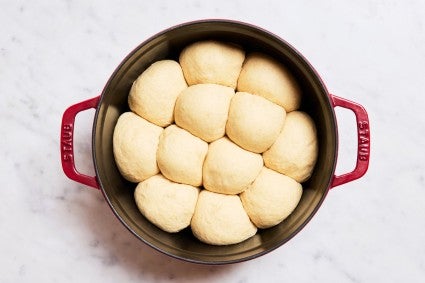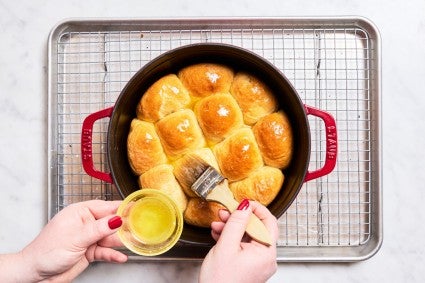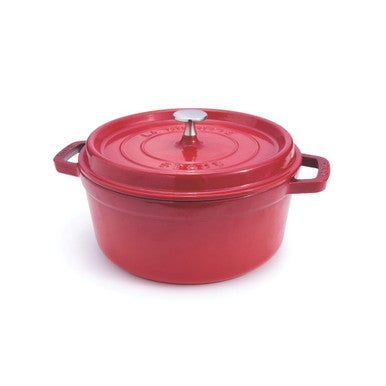My secret to good pull-apart rolls? A Dutch oven.
You acknowledge a Dutch oven is good for making large loaves of crusty artisan bread. Nevertheless it’s moreover an ideal vessel for a further sudden bake: pull-apart rolls. Proper right here’s why.
An important revenue to baking bread in a Dutch oven is that it traps ambient steam from the moisture inside the dough and retains it close to the crust. This trapped moisture retains the crust pliable and prevents it from setting too shortly, which allows the loaf to rise to its most potential as a result of it bakes. Baking in a Dutch oven ensures an artisan loaf has most oven spring (along with an beautiful crispy crust), nevertheless it’s moreover a terrific software program to utilize to get high-rising rolls with a fluffy crumb, as a result of the steam retains the ground of the rolls moist at first of baking.
Actually, for a lot of dinner roll recipes, you’ll see instructions to brush the best with milk, water, egg wash, butter, or one factor associated; that’s to keep up the crust moist and pliable whereas the bread is baking. In case you entice the steam in with the rolls, you might skip this step (although I nonetheless usually brush with butter after the bake, because of butter).
It’s not practically steam, though: A Dutch oven moreover holds and transfers radiant heat correctly. This heat retention contributes to even baking and proper crust formation, which suggests you might get a dinner roll that is delicate and fluffy on the inside, nevertheless has a pleasantly crisp outer crust, versus a soggy bottom (because of no one likes a soggy bottom). It moreover implies that the dinner rolls all bake collectively, so that the edges are nonetheless delicate and peel away in translucent sheets as you pull them apart, which frankly is one among life’s largest joys. In numerous phrases, this baking method offers the right of every worlds: You get a crisp outer crust however moreover the fragile, fluffy texture of pull-apart rolls.
As a bonus, the Dutch oven makes an ideal proofing chamber. Bread needs a warmth, moist environment to proof, and I’ve found the inside of a Dutch oven with the lid on, positioned someplace cozy like in entrance of a warmth oven or on a dough-rising matto be merely the ticket. This revenue is unique to rolls: As soon as we bake artisan bread in a Dutch oven, we preheat the Dutch oven sooner than placing the loaf inside — as a result of the loaf is larger and has further mass, the oven needs further heat to begin out with. Nevertheless the simplest parts of doing dinner rolls in a Dutch oven is that you just simply don’t should preheat it first. The smaller, flatter mass of the dinner rolls transfers heat far more successfully, so you might merely proof the rolls inside the lidded Dutch oven, then pop it straight proper right into a scorching oven.
Want to get started? Do this recipe for Dutch Oven Dinner Rollswhich embrace dried milk inside the dough for an extra-soft texture and a coating of melted butter inside the bottom of the pot for a crispy bottom crust. Nevertheless this method isn’t merely restricted to dinner rolls. Chances are you’ll try it with brioche buns, milk bread buns, monkey bread (identical to the Morning Bun Monkey Bread in my e-book, Baking Bread with Youngsters) — nearly one thing you might nestle collectively to bake and that you just simply must be delicate and fluffy. Seek for a roll recipe that’s meant to be baked in an 8″ or 9″ spherical cake pan, and use the baking instructions inside the Dutch Oven Dinner Rolls recipe as a info.
Whereas buns are always a jewel of the holiday desk, they’re a terrific back-pocket recipe year-round: They make fantastic sandwiches for lunchboxes, leftovers, or solely a quick snack. Escape your Dutch oven for Golden Pumpkin Dinner Rolls — and preserve it spherical all 12 months prolonged for Snug Sourdough Rolls and Full Grain Dinner Rollstoo.
From November 23 to December 31, the Cherry Staub 4 QT Dutch Oven is $220 off!
Cowl image by Patrick Marinello; meals styling by Yekaterina Boytsova.









